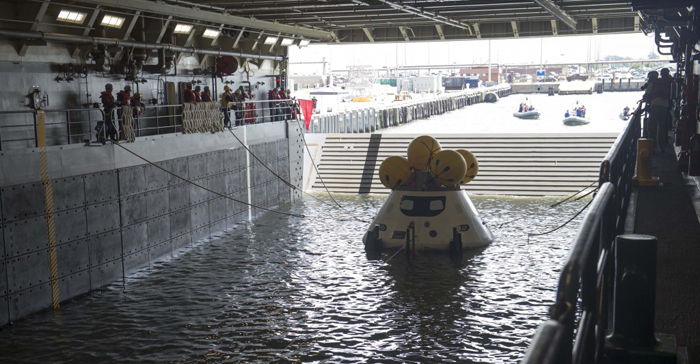By Cmdr. Darren Nelson Navy Live
Commanding Officer, USS Arlington (LPD 24)

Sailors assigned to the amphibious transport dock ship USS Arlington (LPD 24) recover an Orion capsule into the well deck of Arlington as part of NASA’s first key Orion stationary recovery test at Naval Station Norfolk, Aug. 13, 2013. NASA is partnering with the U.S. Navy to develop procedures to recover the Orion capsule and crew after splashdown. (U.S. Navy photo by Mass Communication Specialist Seaman Andrew Schneider/Released)
The first installment of a new and historic partnership between the Department of Defense and National Aeronautics and Space Administration will be launched at Virginia’s Naval Station Norfolk on Aug. 15 when the amphibious transport dock USS Arlington (LPD 24) will conduct a stationary recovery test of the Orion crew module while berthed at Pier 12.
During this test, a waterborne Orion crew module (a 16-foot, four-personnel upgrade of the Apollo capsule, which was half the size and carried a crew of three), assisted by divers and small boats, will be winched into a cradle in Arlington’s well deck.
Sailors assigned to the amphibious transport dock ship USS Arlington (LPD 24) recover an Orion capsule into the well deck of Arlington as part of NASA’s first key Orion stationary recovery test at Naval Station Norfolk. NASA is partnering with the U.S. Navy to develop procedures to recover the Orion capsule and crew after splashdown.
The stationary recovery test with Arlington will allow NASA and the Navy to demonstrate and evaluate the recovery processes, procedures, hardware and personnel in a controlled environment before committing to testing in open waters.
These experimental recovery tests are part of a U.S. government interagency effort to determine the best practices for safely retrieving space craft capable of carrying humans into deep space. The DoD provides unique, validated capabilities to support NASA’s requests for operational support without adversely impacting the department’s primary warfighting mission.
LPD 17-class ships (such as Arlington) boast the ability to embark helicopters, launch and recover small boats, three-dimensional air search radar and advanced medical facilities, making them uniquely suited to contribute to this project.
Of course, Arlington’s crew of Sailors and Marines and I are thrilled to be a part of this!
The U.S. Navy has been part of America’s space program almost since the beginning. From 1961 to 1975, Navy ships recovered Mercury, Gemini and Apollo spacecraft after splashing down in the oceans, transporting capsules and crews safely to land.
Several of these recoveries were assisted by USS Arlington’s predecessor, the second ship in the U.S. fleet to bear the name. On Dec. 27, 1968, the major communications relay ship USS Arlington (AGMR 2) assisted in the recovery of Apollo 8 after its splashdown in the Northern Pacific. The following year, Arlington aided in the recovery of Apollo 10 on May 26. Most famously, the ship took part in the recovery of Apollo 11 (the first to land on the moon) on July 24, 1969.
As the captain of a Navy warship, and for virtually every member of my crew, this opportunity to work with NASA is a once-in-a-lifetime opportunity. Lessons learned from these tests will be used in Navy dive team training, crew module recovery procedures, support equipment design, dockside handling procedures and equipment and personnel task loading.
During the stationary recovery test, Arlington will assist NASA in demonstrating and evaluating procedures and support equipment, accomplishing dockside handling to load and unload a well deck recovery ship, performing, and determining the type and number of Navy small boat teams needed to accomplish the recovery tasks.

Sailors assigned to the amphibious transport dock ship USS Arlington (LPD 24) recover an Orion capsule into the well deck of Arlington as part of NASA’s first key Orion stationary recovery test at Naval Station Norfolk, Aug 13, 2013. NASA is partnering with the U.S. Navy to develop procedures to recover the Orion capsule and crew after splashdown. (U.S. Navy photo by Mass Communication Specialist Seaman Andrew Schneider/Released)
But it is the bigger picture that is truly amazing.
Orion is America’s next-generation spacecraft that will take astronauts to new destinations never explored by humans. It will carry crews to distant planetary bodies, provide emergency abort capability, sustain the crew during space travel and provide safe re-entry from deep space. NASA also is developing a heavy-lift rocket, the Space Launch System, to expand human presence to celestial destinations beyond low-Earth orbit. This launch vehicle will be capable of lifting Orion to a variety of potential destinations including asteroids, the moon, and ultimately to Mars. Building on five decades of launch and vehicle processing excellence, NASA’s existing infrastructure and facilities are being modernized to support processing and launch of multiple vehicles, from next-generation rockets and spacecraft to those developed by commercial companies.
Arlington is truly proud to contribute to the stationary recovery test, one small step toward the future success of human space flight and U.S. national space policies and programs, one that will ultimately lead toward another large step for mankind.

